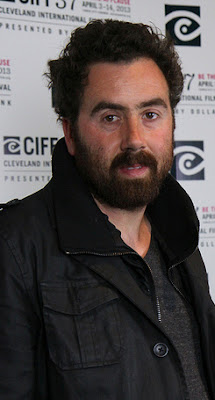ELEMENTAL begins with a quote from T.S. Eliot, something to the effect that, by taking a risk, we learn just how far we can go. This new documentary then introduces us to three very different people, spread out around the globe -- in India, Australia and Canada -- intent on helping save our dying environment, each in his/her own special way.
Out of all the folk currently working to save our environment in countless different ways, how and why
filmmakers Gayatri Roshan (shown at right) and Emmanuel Vaughan-Lee chose these particular three people seems to TrustMovies perhaps a little arbitrary. Ms Roshan is from India, as is her subject Rajendra Singh, who is intent on purifying (or at least cleaning up) the water of India's famous Ganges river. The movie begins, in fact, with spillage from a leather tanning factory polluting the Ganges.
Mr. Vaughan-Lee, the British filmmaker and musician/
composer shown at left, is the son of a Sufi mystic and has for some time been involved in projects to do with -- as is this one -- helping our world sustain itself.
This sustainability is also paramount in the minds of our three protagonists, the other two of whom include Eriel Tchekwie Deranger (shown below), a young woman of Native Canadian heritage, who -- via the Rainforest Action Network -- is fighting the Canadian Tar Sands development and the banks who are funding the project, and Jay Harman, a scientist/inventor from Australia who uses nature's own curling motion as a design to guide his projects into helping cool down the planet.
The work of Mr. Harman (the gentleman is shown below) proves the most exciting and unusual that the movie offers. We see a few of his projects, and each one -- dealing with the cleaning of water using that special spiral motion or with the movement of air and the possibility of removing pollution via nature's own special design -- seems not just possible but even probable.
The problem with the movie is that we just keep wanting more, but as soon as some thought or idea engages us -- wham: we're off to spend time with one of the other activists. This constant cutting between the three grows more tiresome and annoying as the movie proceeds because we're always left wanting more but getting less.
Why exactly has not Harman's projects taken off? The economic downturn, for one thing, but we come away from this film either suspicious or disappointed in how little we've really learned. While Ms Deranger proves the most interesting and accessible from the personal angle (she meets a very nice guy during her activism, and soon they are together and she's expecting, as shown below, his child), we keep learning just enough to want additional information. We're told that the Tar Sands project pits family against family and jobs against the environment (and is very much connected to our own proposed Keystone Pipeline)-- but the details that might better involve us are nowhere to be found.
Ditto Mr. Singh (below), whom we really learn the least about and who seems to flit from one place and project to another. At one point, the local people point out that so-called activists and government representatives come with promises but then leave without doing anything for the locals. What did Singh do in this particular place? We never learn the answer.
Both the film and its three interesting protagonists are worthy of our time, all right. But better use could have been made of that time. Any one of these activists and his/her work would easily fill up 90 minutes. Tossing them into a single film and then editing their information together into the shards seen here is not very edifying.
The oddly-titled Elemental, running 92 minutes, opens this coming Friday, May 17, in Manhattan at the Cinema Village, with a subsequent release planned for San Francisco, San Rafael, Portland, Bellingham, Austin and Washington DC -- with other cities to follow. The film is also available to bring to your city via tugg.
Saturday, May 11, 2013
Subscribe to:
Post Comments (Atom)











No comments:
Post a Comment